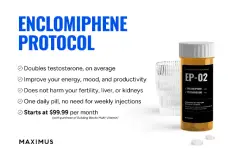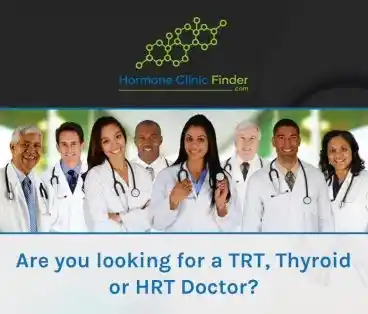Hello,
I am new here and hope to learn loads about my health as a 54m from the UK. I've been doing some poking around the web and YouTube and in
looking at how I feel in general, felt I may have some testosterone issues and want to see if TRT is right for me.
I went to my GP and they did some blood work. They checked my Serum Testosterone Level and it came back with a score of 9.4 nmol/L. They say that "normal levels" are between 6.0 and 27.0 so the Doctor said I was "normal".
In your opinion, would it be worth it to come out of pocket to see a specialist and see what they say the next steps should be? I exude many of the classic symptoms of low test -
- E.D.
- Fatigue
- Overweight
- Losing muscle mass
- low libido
- brain fog
The stories I am seeing is that people that start TRT can have amazing results. I just generally feel like crap and "low" most of the time and don't think at 54 I should feel this way.
With a score of 9 on my bloodwork, the NHS won't really do anything so I want to take control of my health and wellbeing from here.
What are your thoughts on that reference level and desire for increased overall energy and well being?
Thanks for the insight!
Cheers,
Dave
Welcome to Nelson's domain Dave!
Forget getting caught up in the reference ranges especially when it comes to the bottom end!
Many men can suffer from hypogonadism/low-T with a TT in the low-normal range let alone even in the normal range in cases of men with high SHBG which would have their FT low/lowish.
Signs and symptoms of low-T along with labs showing low/sub-par free testosterone are what truly matters.
TT does not paint the full picture as you also need to know where your SHBG sits then you can see where your FT truly sits.
When it comes to testing using the most accurate assays is critical especially when it comes to testing free testosterone.
Although TT is important to know FT is what truly matters as it is the active unbound fraction of testosterone responsible for the positive effects.
Blood work should always be done in the early am in a fasted state let and make sure you are well rested.
We always want to test (TT, FT, and BAT) when blood levels peak in the early am.
The natural endogenous 24-hour circadian rhythm of a healthy young male has T levels peaking (highest point) in the early am upon awakening whereas the nadir or trough (lowest point) will be in the evening.
If you weight train it would be advantageous to take a week off before getting blood work done.
As you can see you are hitting an absurdly low TT 9.4 nmol/L (271 ng/dL) and with a TT in the mid-high 200s it is a given that your FT will be lowish/low even if you had low SHBG.
Most men can easily get treated with a TT <300ng/dL.
Even though they are very strict in the UK and many doctors are clueless when it comes to treating men for low testosterone with a dismal TT 9 nmol/L SHBG you would still qualify for TRT under the most recent BSSM Guidelines.
The best piece of advice would be to seek out a doctor who specializes in treating men for low-T.
Stay far away from those dime-a-dozen run-of-the-mill T-clinics that would be more than happy to jack you up on T from the get-go!
Start low and go slow on a T-only protocol we say.
Patience is key especially when starting TRT.
Keep us posted.
The British Society for Sexual Medicine Guidelines on Male Adult Testosterone Deficiency, With Statements for Practice (2023) Geoffrey Hackett, Michael Kirby, Rowland W. Rees, T. Hugh Jones, Asif Muneer, Mark Livingston, Nick Ossei-Gerning, Janine David, Jeff Foster, Philip A. Kalra, Sudarshan...

www.excelmale.com
LABORATORY DIAGNOSIS
It is important that clinicians familiarise themselves with their local laboratories. TD is a diagnosis made from clinical symptoms and abnormal biochemistry. Clinicians need to appreciate that “reference ranges” quoted by laboratories represent the normal population and that the “action levels” recommended by BSSM refer to men with clinical symptoms of TD (Fig. 2). Just as reference ranges on normal lipids are inappropriate for men with T2DM and for secondary prevention in CHD, reference ranges for testosterone are not designed to replace evidence-based guidelines. Wide variations in laboratory practice for testosterone testing in the UK may lead to variations in patient care and potentially result in some patients with TD not being identified. Improvements in the standardization of testosterone assays and the consistency of reporting between laboratories are required.
Where TT levels are close to the lower normal range (8–12 nmol/L), the FT level should also be checked (LoE1, Grade A) [4,5]. Where the TT levels are <12 nmol/L, serum LH and FSH levels should also be measured. Where TT is borderline or low to normal, particularly in obese and older men, SHBG levels should also be checked (LoE 2, Grade C) [6]. In the case of known or suspected abnormal SHBG levels, FT should also be measured (LoE 1, Grade A). LH levels should be assessed to differentiate between primary and secondary TD (LoE 2, Grade A) [4]. Serum prolactin levels should be measured when both LH and FSH levels are low. A very low TT (<5.2 nmol/L), and low LH and FSH are more likely to be associated with hyperprolactinemia, or when secondary TD due to a pituitary tumor or other pituitary disease is suspected
THRESHOLDS FOR T THERAPY
Regarding the thresholds for treatment intervention in symptomatic men, BSSM [1,5] and ISSM guidelines recommend the following:
• TT level <12 nmol/L or FT <225 pmol/L (<0.225nmol/L) (based on two separate 8–11 am levels), usually requires T Therapy (LoE=1 Grade A) [1].
• TT level >12 nmol/L, or FT of >225 pmol/L (>0.225nmol/L), does not require T Therapy (LoE=Grade 1Grade A) [1].
• Levels between 8–14 nmol/L may require a trial of T Therapy for a minimum of 6 months, based on symptom (LoE = 3, Grade C) [117]. The BSSM also says (Table 4):
• Evidence supports the treatment of men with TT levels <14 nmol/L in symptomatic men with prediabetes to prevent progression to overt type 2 diabetes (LoE=2 Grade B) [53].
• A FT level <225 pmol/L (0.225 nmol/L) provides supportive evidence for T Therapy in the presence of appropriate symptoms (LoE=1 Grade A) [122]. Additional recommendations include:
• Raised LH levels and testosterone below normal or in the lower quartile range, indicate testicular failure, so T Therapy should be considered based on symptom severity [123].
• Raised LH levels in men with normal testosterone levels but symptoms of TD, should be considered as TD [26].
• Data from EMAS [123] found that clinical symptoms and all-cause mortality were more closely related to calculated FT (LoE 2 Grade=B) [124].
Fig. 2. BSSM Guidelines 2022. Diagnosing and managing TD in adult men. BSSM: British Society for Sexual Medicine, TD: testosterone deficiency, TT: total testosterone, LH: luteinizing hormone, FSH: follicle-stimulating hormone, SHBG: sex-hormone-binding globulin, FT: free testosterone, DRE: digital rectal examination, PSA: prostate-specific antigen, CV: cardiovascular, CVD: cardiovascular disease, ED: erectile dysfunction, hCG: human chorionic gonadotropin,
T Therapy: testosterone therapy. For men with TT levels <5.2 nmol/L plus low LH and FSH or increased prolactin levels, refer to endocrinology or arrange a pituitary MRI to exclude a pituitary adenoma [2,15]. The T4DM study [53] showed a 21% reduction in progression to T2DM by treating T <14 nmol/L in men with pre-diabetes.














